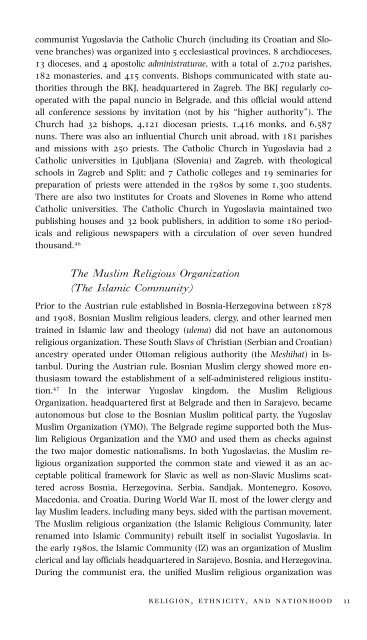Balkan Idols: Religion and Nationalism in Yugoslav States
Balkan Idols: Religion and Nationalism in Yugoslav States
Balkan Idols: Religion and Nationalism in Yugoslav States
You also want an ePaper? Increase the reach of your titles
YUMPU automatically turns print PDFs into web optimized ePapers that Google loves.
communist <strong>Yugoslav</strong>ia the Catholic Church (<strong>in</strong>clud<strong>in</strong>g its Croatian <strong>and</strong> Slovene<br />
branches) was organized <strong>in</strong>to 5 ecclesiastical prov<strong>in</strong>ces, 8 archdioceses,<br />
13 dioceses, <strong>and</strong> 4 apostolic adm<strong>in</strong>istraturae, with a total of 2,702 parishes,<br />
182 monasteries, <strong>and</strong> 415 convents. Bishops communicated with state authorities<br />
through the BKJ, headquartered <strong>in</strong> Zagreb. The BKJ regularly cooperated<br />
with the papal nuncio <strong>in</strong> Belgrade, <strong>and</strong> this official would attend<br />
all conference sessions by <strong>in</strong>vitation (not by his “higher authority”). The<br />
Church had 32 bishops, 4,121 diocesan priests, 1,416 monks, <strong>and</strong> 6,587<br />
nuns. There was also an <strong>in</strong>fluential Church unit abroad, with 181 parishes<br />
<strong>and</strong> missions with 250 priests. The Catholic Church <strong>in</strong> <strong>Yugoslav</strong>ia had 2<br />
Catholic universities <strong>in</strong> Ljubljana (Slovenia) <strong>and</strong> Zagreb, with theological<br />
schools <strong>in</strong> Zagreb <strong>and</strong> Split; <strong>and</strong> 7 Catholic colleges <strong>and</strong> 19 sem<strong>in</strong>aries for<br />
preparation of priests were attended <strong>in</strong> the 1980s by some 1,300 students.<br />
There are also two <strong>in</strong>stitutes for Croats <strong>and</strong> Slovenes <strong>in</strong> Rome who attend<br />
Catholic universities. The Catholic Church <strong>in</strong> <strong>Yugoslav</strong>ia ma<strong>in</strong>ta<strong>in</strong>ed two<br />
publish<strong>in</strong>g houses <strong>and</strong> 32 book publishers, <strong>in</strong> addition to some 180 periodicals<br />
<strong>and</strong> religious newspapers with a circulation of over seven hundred<br />
thous<strong>and</strong>. 46<br />
The Muslim Religious Organization<br />
(The Islamic Community)<br />
Prior to the Austrian rule established <strong>in</strong> Bosnia-Herzegov<strong>in</strong>a between 1878<br />
<strong>and</strong> 1908, Bosnian Muslim religious leaders, clergy, <strong>and</strong> other learned men<br />
tra<strong>in</strong>ed <strong>in</strong> Islamic law <strong>and</strong> theology (ulema) did not have an autonomous<br />
religious organization. These South Slavs of Christian (Serbian <strong>and</strong> Croatian)<br />
ancestry operated under Ottoman religious authority (the Meshihat) <strong>in</strong> Istanbul.<br />
Dur<strong>in</strong>g the Austrian rule, Bosnian Muslim clergy showed more enthusiasm<br />
toward the establishment of a self-adm<strong>in</strong>istered religious <strong>in</strong>stitution.<br />
47 In the <strong>in</strong>terwar <strong>Yugoslav</strong> k<strong>in</strong>gdom, the Muslim Religious<br />
Organization, headquartered first at Belgrade <strong>and</strong> then <strong>in</strong> Sarajevo, became<br />
autonomous but close to the Bosnian Muslim political party, the <strong>Yugoslav</strong><br />
Muslim Organization (YMO). The Belgrade regime supported both the Muslim<br />
Religious Organization <strong>and</strong> the YMO <strong>and</strong> used them as checks aga<strong>in</strong>st<br />
the two major domestic nationalisms. In both <strong>Yugoslav</strong>ias, the Muslim religious<br />
organization supported the common state <strong>and</strong> viewed it as an acceptable<br />
political framework for Slavic as well as non-Slavic Muslims scattered<br />
across Bosnia, Herzegov<strong>in</strong>a, Serbia, S<strong>and</strong>jak, Montenegro, Kosovo,<br />
Macedonia, <strong>and</strong> Croatia. Dur<strong>in</strong>g World War II, most of the lower clergy <strong>and</strong><br />
lay Muslim leaders, <strong>in</strong>clud<strong>in</strong>g many beys, sided with the partisan movement.<br />
The Muslim religious organization (the Islamic Religious Community, later<br />
renamed <strong>in</strong>to Islamic Community) rebuilt itself <strong>in</strong> socialist <strong>Yugoslav</strong>ia. In<br />
the early 1980s, the Islamic Community (IZ) was an organization of Muslim<br />
clerical <strong>and</strong> lay officials headquartered <strong>in</strong> Sarajevo, Bosnia, <strong>and</strong> Herzegov<strong>in</strong>a.<br />
Dur<strong>in</strong>g the communist era, the unified Muslim religious organization was<br />
religion, ethnicity, <strong>and</strong> nationhood 11


